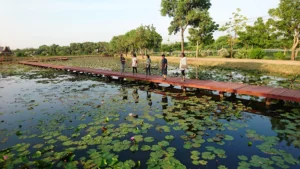
About Wat Phrathat Dum: Ancient Temple Ruins, Sakon Nakhon City
Description
If you find yourself wandering through Sakon Nakhon City and have a penchant for history wrapped in a little mystery, Wat Phrathat Dum is a spot you seriously shouldn’t overlook. Now, I gotta admit, it’s not the most flashy temple you’ll ever bump into in Thailand, but don't let that fool you. This place carries some serious ancient vibes that whisper stories of centuries past—think crumbling brick stupas and weather-worn sculptures that’ve stood the test of time in a way that’s almost poetic.
Unlike the polished temples packed with tourists in Bangkok, Wat Phrathat Dum offers a more laid-back, somewhat raw encounter with history. It feels like stepping back into a quieter, less commercial era, where you can almost hear the faint echoes of monks chanting and the soft shuffle of pilgrims over old stones. The temple dates back to an era closely tied to the Khmer empire's influence in the region, which adds a fascinating layer to its significance, especially for those who geek out over Southeast Asian archaeology.
One of the neat things? The site is surprisingly easy to access for those with mobility challenges, which is always a huge plus when you’re navigating ruins or outdoor paths. It’s not every ancient temple where you can roll up in a wheelchair without a fuss, so that’s worth giving a nod to!
One quirky tidbit from my visit: while roaming the grounds, I noticed how the sunlight hit the old bricks at just the right angle in the late afternoon, turning the entire space into this golden, almost magical amber glow. It’s moments like these that stick with you—something photographers would absolutely drool over, even though you might just be a casual traveler looking to soak in some culture.
That said, don’t expect a shopping mall around the corner or flashy visitor centers. Wat Phrathat Dum feels more like a hidden gem, the kind of place locals seem to cherish but which flies under the radar of most international tourists. Which, in my book, is part of the appeal—less crowd chaos, just you, history, and the humbling grandeur of a site that’s seen a lot of sunrises and sunsets over the centuries.
Key Features
- Ancient brick stupas showcasing classic Khmer architectural style unique to Northeast Thailand
- Well-preserved archaeological ruins offering a tangible connection to Sakon Nakhon’s historical past
- Wheelchair accessible entrance and parking, making the temple grounds easier to explore for visitors with mobility needs
- Scenic, tranquil atmosphere away from the usual tourist hustle, perfect for quiet reflection and photography
- Close proximity to other cultural spots in Sakon Nakhon, ideal for a day of exploration around the city
- Informative onsite plaques providing insights into the temple’s history and significance (though some knowledge of Khmer influence helps)
- Local vendors nearby selling traditional snacks and drinks—great fuel for your temple trek
- Less-commercialized setting allows more authentic interaction with local spirituality and architecture
Best Time to Visit
Honestly, if you wanna catch Wat Phrathat Dum at its absolute best, aim for the cooler months between November and February. The weather is way more comfortable then—no sweaty trudging through ruins when the sun is blasting you like a furnace. Plus, the skies are clearer, so that stunning golden-hour light I mentioned before really does some magic on the temple’s ancient bricks.
Visiting early in the morning or late afternoon is key, both to avoid midday heat and to see the temple in gentle, soft lighting that’s just better for exploring and snapping photos. Midday can be brutal, especially in the dry season, and you’ll probably want a shady spot and a cold drink more than anything else.
A little heads-up: the rainy season (around May to October) can make getting around a bit muckier, and the atmosphere a bit gloomier, but there’s a strange kind of quiet beauty then too. Just bring good waterproof shoes and maybe an umbrella if you’re feeling brave—and hey, fewer people will be around if you don’t mind a little mud.
How to Get There
Getting to Wat Phrathat Dum isn’t exactly a mystery but does require a bit of planning if you’re not already stationed in Sakon Nakhon. From the city center, the temple is relatively close but tucked away enough that you’ll want a reliable mode of transportation. Renting a scooter or car is seriously your best bet for flexibility, especially if you want to poke around other nearby ruins or cultural sights in the area.
For the more adventurous or socially savvy, tuk-tuks and motorbike taxis are an option. Just make sure to agree on a price beforehand— this part of Thailand isn’t as aggressively touristy, so sometimes you might find yourself negotiating with someone who’s not-so-used to the usual tourist pricing dance.
Public transport options exist but are less straightforward—buses or songthaews might drop you off nearby, but expect some walking (or hitching a quick tuk-tuk) to reach the exact site. It’s not a hassle per se, but if you’re pressed for time or not keen on walking, grabbing a personal ride is just easier.
Once there, well-marked signs and friendly locals should help you find the way around the temple complex quite easily. It’s one of those places that rewards a bit of exploration—so feel free to take your time and wander off the beaten path if you’re curious.
Tips for Visiting
Now, let me save you some rookie mistakes I’ve witnessed (and sometimes made myself) when visiting spots like Wat Phrathat Dum. First off, wear comfortable shoes—this isn’t a spot for your fancy sandals or heels. The temple grounds can be uneven, with loose bricks and dirt paths, so sturdy footwear will save your feet and keep you steady.
Bring water. This sounds obvious, but trust me, the last thing you want is to nearly pass out from dehydration before you’ve even soaked in the place. And since it’s not swamped with vendors inside the ruins, it’s better to come prepared. A hat or cap might also be your best friend, especially if you visit during the sunnier months.
Respect the site. It’s easy to get caught up in the grandeur and snap tons of photos, but remember this is a place of cultural and historical importance. Don’t climb on delicate structures or disturb any offerings you might see. Local monks or caretakers are usually around—say a friendly hello or ask politely if you’re unsure about any customs.
Oh, and a little nugget I learned the hard way: if you’re planning to use your phone for navigation or pics, make sure it’s well-charged. There’s no fancy charging stations here, and you won’t want to miss out on capturing those golden-hour vibes just because your battery died at the wrong moment.
Finally, talk to locals if you get the chance. They often have stories or tidbits about the temple’s history or seasonal festivals that you won’t find in any guidebook. Sometimes, these conversations become the highlight of your visit—they make the ancient bricks feel alive, connected to people and their passions.


